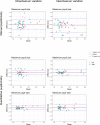Superior reproducibility and repeatability in automated quantitative pupillometry compared to standard manual assessment, and quantitative pupillary response parameters present high reliability in critically ill cardiac patients
- PMID: 35901103
- PMCID: PMC9333219
- DOI: 10.1371/journal.pone.0272303
Superior reproducibility and repeatability in automated quantitative pupillometry compared to standard manual assessment, and quantitative pupillary response parameters present high reliability in critically ill cardiac patients
Abstract
Background: Quantitative pupillometry is part of multimodal neuroprognostication of comatose patients after out-of-hospital cardiac arrest (OHCA). However, the reproducibility, repeatability, and reliability of quantitative pupillometry in this setting have not been investigated.
Methods: In a prospective blinded validation study, we compared manual and quantitative measurements of pupil size. Observer and device variability for all available parameters are expressed as mean difference (bias), limits of agreement (LoA), and reliability expressed as intraclass correlation coefficients (ICC) with a 95% confidence interval.
Results: Fifty-six unique quadrupled sets of measurement derived from 14 sedated and comatose patients (mean age 70±12 years) were included. For manually measured pupil size, inter-observer bias was -0.14±0.44 mm, LoA of -1.00 to 0.71 mm, and ICC at 0.92 (0.86-0.95). For quantitative pupillometry, we found bias at 0.03±0.17 mm, LoA of -0.31 to 0.36 mm and ICCs at 0.99. Quantitative pupillometry also yielded lower bias and LoA and higher ICC for intra-observer and inter-device measurements. Correlation between manual and automated pupillometry was better in larger pupils, and quantitative pupillometry had less variability and higher ICC, when assessing small pupils. Further, observers failed to detect 26% of the quantitatively estimated abnormal reactivity with manual assessment. We found ICC >0.91 for all quantitative pupillary response parameters (except for latency with ICC 0.81-0.91).
Conclusion: Automated quantitative pupillometry has excellent reliability and twice the reproducibility and repeatability than manual pupillometry. This study further presents novel estimates of variability for all quantitative pupillary response parameters with excellent reliability.
Conflict of interest statement
The authors have declared that no competing interests exist.
Figures




Similar articles
-
Comparison of 2 Automated Pupillometry Devices in Critically III Patients.J Neurosurg Anesthesiol. 2020 Oct;32(4):323-329. doi: 10.1097/ANA.0000000000000604. J Neurosurg Anesthesiol. 2020. PMID: 31033624
-
Validating quantitative pupillometry thresholds for neuroprognostication after out-of-hospital cardiac arrest. A predefined substudy of the Blood Pressure and Oxygenations Targets After Cardiac Arrest (BOX)-trial.Intensive Care Med. 2024 Sep;50(9):1484-1495. doi: 10.1007/s00134-024-07574-6. Epub 2024 Aug 20. Intensive Care Med. 2024. PMID: 39162825 Free PMC article.
-
Feasibility and Variability of Automated Pupillometry Among Stroke Patients and Healthy Participants: Potential Implications for Clinical Practice.J Neurosci Nurs. 2019 Apr;51(2):84-88. doi: 10.1097/JNN.0000000000000416. J Neurosci Nurs. 2019. PMID: 30489422
-
Role of automated pupillometry in critically ill patients.Minerva Anestesiol. 2019 Sep;85(9):995-1002. doi: 10.23736/S0375-9393.19.13437-2. Epub 2019 Mar 29. Minerva Anestesiol. 2019. PMID: 30938123 Review.
-
Automated Pupillometry in Neurocritical Care: Research and Practice.Curr Neurol Neurosci Rep. 2019 Aug 23;19(10):71. doi: 10.1007/s11910-019-0994-z. Curr Neurol Neurosci Rep. 2019. PMID: 31440851 Review.
Cited by
-
PUPILLARY REFLEX AT EASE: A new instrument for the demonstration of Pupillary reflex.Indian J Ophthalmol. 2025 Jun 1;73(Suppl 3):S508-S510. doi: 10.4103/IJO.IJO_717_24. Epub 2025 May 30. Indian J Ophthalmol. 2025. PMID: 40444313 Free PMC article.
-
Assessing bedside measures of autonomic nervous system dysregulation in the PICU.Pediatr Res. 2025 Feb 6. doi: 10.1038/s41390-024-03778-0. Online ahead of print. Pediatr Res. 2025. PMID: 39915613
-
Updates on Post-Resuscitation Care. After the Return of Spontaneous Circulation beyond the 2021 Guidelines.Rev Cardiovasc Med. 2022 Oct 31;23(11):373. doi: 10.31083/j.rcm2311373. eCollection 2022 Nov. Rev Cardiovasc Med. 2022. PMID: 39076196 Free PMC article. Review.
-
Pupillometry in the Emergency Department: A Tool for Predicting Patient Disposition.West J Emerg Med. 2025 Jul 7;26(4):1078-1085. doi: 10.5811/westjem.39912. West J Emerg Med. 2025. PMID: 40794983 Free PMC article.
-
Machine Learning Approaches to Prognostication in Traumatic Brain Injury.Curr Neurol Neurosci Rep. 2025 Feb 19;25(1):19. doi: 10.1007/s11910-025-01405-x. Curr Neurol Neurosci Rep. 2025. PMID: 39969697 Review.
References
-
- Azabou E, Rohaut B, Heming N, Magalhaes E, Morizot-Koutlidis R, Kandelman S, et al.. Early impairment of intracranial conduction time predicts mortality in deeply sedated critically ill patients: a prospective observational pilot study. Ann Intensive Care. 2017. Dec;7(1):63. doi: 10.1186/s13613-017-0290-5 - DOI - PMC - PubMed
Publication types
MeSH terms
LinkOut - more resources
Full Text Sources
Medical

